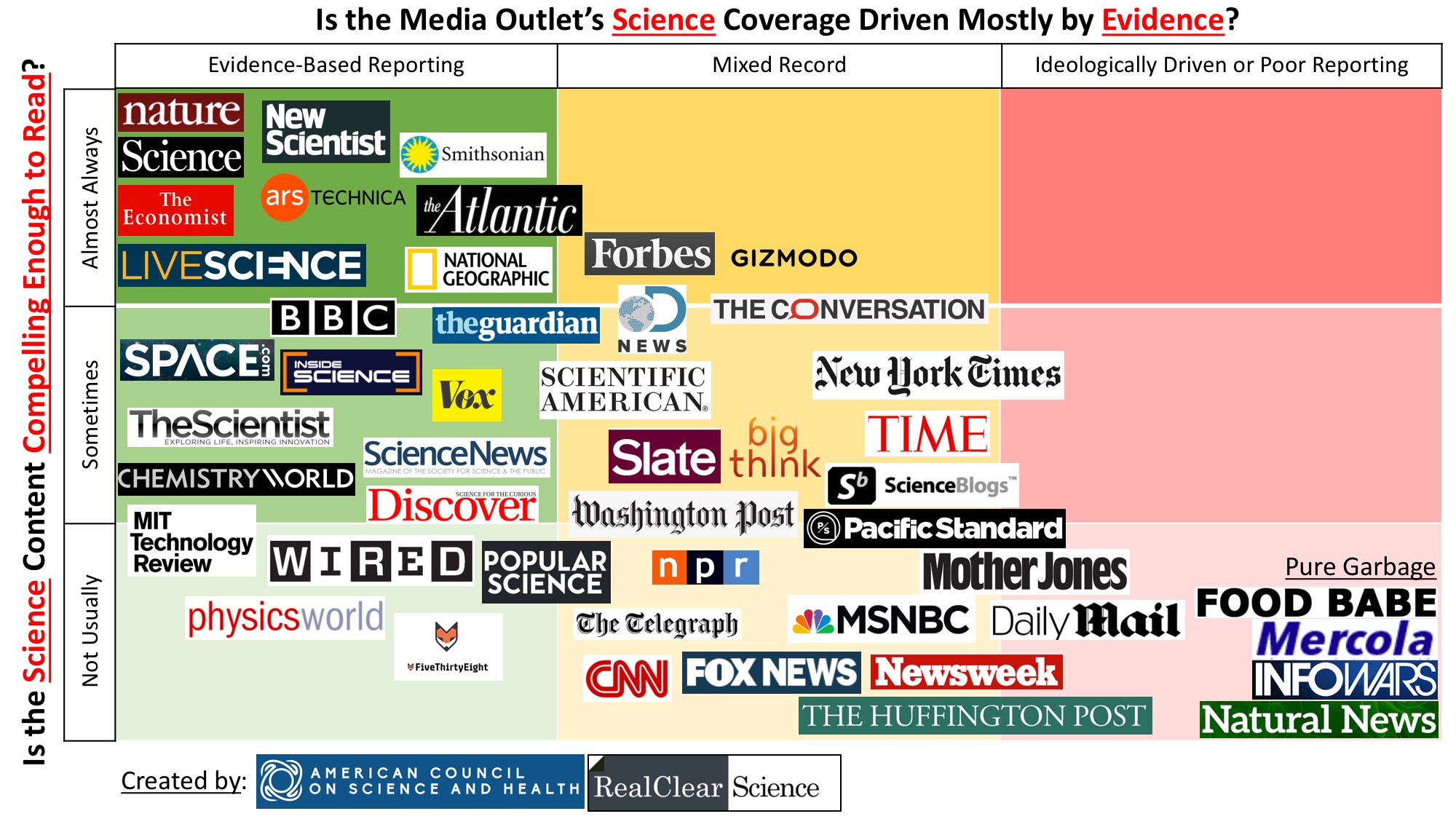A common question I hear again and again is, "How do I know if a news story is fake?" There is no easy answer1. It helps to be well informed, and it requires a conscious suspension of credulity combined with a gut instinct honed over years of experience.
If journalism as a whole is bad (and it is), science journalism is even worse. Not only is it susceptible to the same sorts of biases that afflict regular journalism, but it is uniquely vulnerable to outrageous sensationalism. Every week, it seems, an everyday food is either going to cure cancer or kill us all.
One thing experience has taught us is that some news outlets are better than others. Some journalists really do care about reporting the news as it is rather than the way they would like it to be. So, in an effort to promote good science news sources while castigating the bad, we teamed up with RealClearScience to create an infographic.
On the X-axis (from left to right), we rank sources by their fundamental trustworthiness. Media outlets in the green column produce scientific content that is based on evidence and is largely free of ideology. Sources in the red column, on the other hand, are driven by ideology and are characterized by lopsided reporting. Evidence plays little to no role for these outlets.
On the Y-axis (from top to bottom), we rank media outlets based on whether they are compelling sources of information. Outlets toward the top are of broad general interest and are well reported. Outlets toward the bottom are of limited interest or are poorly reported. (By "poorly reported," we mean either the topic selection is dull or the content is mostly fluff or sensationalism.)
(RealClearScience also has its own analysis of this infographic.)
Why Is THAT Source Listed There?
Some of our rankings may surprise you. Here are more detailed explanations for a few specific choices2:
The best of the best. By far, the two best sources of science news (besides ACSH and RealClearScience, of course!) are Nature and Science, both of which have news sections aimed at the general public. The Economist is excellent for people who are mostly interested in global news and politics but have a curiosity for science. NewScientist and Live Science are perfect for true science geeks.
No love for Popular Science and Wired? They're okay. While some of their content is good, our biggest problem with them is that they are prone to wide-eyed speculation and clickbait rather than serious science news analysis. Physics World has the opposite problem. It is very serious and well reported, but the topic selection is esoteric and of interest to few people.
What's wrong with Scientific American? For a long while, Scientific American became the headquarters for left-wing social justice warriors and others who felt bashing conservatives was more important than reporting good science. (Previously, that dubious distinction went to ScienceBlogs, but nobody reads that anymore.) SciAm's best content is generally stuff they reprint from other outlets.
The New York Times is a joke. The NYT -- America's alleged newspaper of record -- has itself quite a record of unscientific transgressions. The paper promotes dubious fad diets, cited the quack Joe Mercola on a story about the safety of wearable electronics, and gives voice to organic foodies. It also published a story on a fake disease called post-treatment Lyme disease syndrome. The NYT regularly reports false information on GMOs and agriculture, perhaps none so egregious as this utterly abominable article by Danny Hakim that compared pesticides to Nazi-made sarin gas. If it wasn't for the fact that some respectable writers like John Tierney and Carl Zimmer also publish there, the NYT's science coverage would be comparable to that of the Huffington Post.
Beware British tabloids. News sources like the Daily Mail and The Telegraph serve up a disproportionate amount of sensationalist garbage. Avoid.
Not a single cable news source is worth your time. While CNN, Fox News, and MSNBC might be useful for other things, they are mostly awful sources of science news. Any science news reported here should be verified for accuracy.
Pure garbage. The biggest purveyors of fake science news are Natural News, Mercola, The Food Babe, and InfoWars. If they ever report something truthful, it is almost certainly by accident. Even a broken clock is correct twice per day.
Notes
(1) Here is a list of ten tips to help you detect fake news.
(2) Full disclosure: ACSH and RCS have a reprinting agreement with LiveScience. This did not impact our rating, however, because we would not establish a reprinting agreement with an outlet we felt was not evidence-based.





